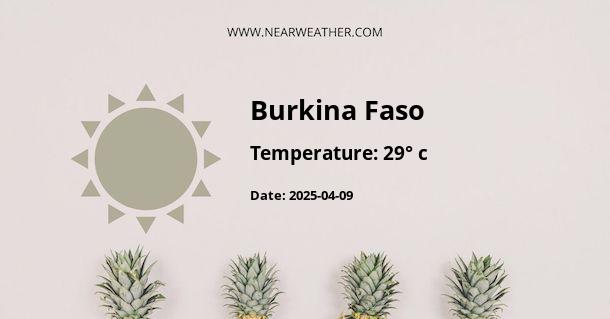Climate and Weather in Burkina Faso
Burkina Faso, a landlocked country located in West Africa, experiences a subtropical climate with distinct wet and dry seasons. The country's diverse topography, ranging from savannahs to Sahelian semi-deserts, contributes to variations in weather patterns across different regions.
Seasonal Variations
1. Dry Season: The dry season in Burkina Faso typically lasts from November to April. During this period, the country experiences hot and arid conditions, with low humidity and minimal rainfall. Daytime temperatures often exceed 30°C (86°F), while nighttime temperatures can drop to around 15°C (59°F) in some areas.
2. Wet Season: The wet season in Burkina Faso occurs from May to October, bringing relief from the scorching heat. This period is characterized by increased rainfall, higher humidity levels, and cooler temperatures. The southern regions of the country receive more precipitation compared to the northern regions.
Temperature
The average annual temperature in Burkina Faso ranges between 25°C (77°F) and 30°C (86°F). However, there are noticeable temperature variations throughout the year.
During the dry season, temperatures can soar to above 40°C (104°F) in some areas, particularly in the northern part of the country. The Harmattan winds, blowing from the Sahara Desert, can also cause a drop in temperatures during this season.
In contrast, the wet season brings cooler temperatures, with daytime highs ranging from 25°C (77°F) to 35°C (95°F) in most regions. The increased cloud cover and rainfall help to moderate the heat during this period.
Rainfall
Rainfall patterns in Burkina Faso vary significantly between the north and south of the country. The southern regions receive higher amounts of precipitation compared to the drier northern regions.
The northern part of Burkina Faso, including areas like Ouagadougou and Bobo-Dioulasso, experiences an average annual rainfall of around 600mm (23.6 inches). Most of this rainfall occurs during the wet season, particularly in July and August.
In contrast, the southern regions, such as Banfora and Gaoua, receive an average annual rainfall of about 900mm (35.4 inches). These areas experience a bimodal rainfall pattern, with two peaks of rainfall occurring in June and September.
Extreme Weather Events
Burkina Faso is prone to occasional extreme weather events, including droughts, floods, and dust storms.
Droughts: The country is susceptible to periodic droughts, particularly during the dry season. These droughts can have severe impacts on agriculture and food security.
Floods: Heavy rainfall during the wet season can lead to flooding, especially in low-lying areas. Flooding can cause damage to infrastructure, displacement of communities, and loss of crops and livestock.
Dust Storms: The Harmattan winds, blowing from the Sahara Desert, can bring dust storms to Burkina Faso, reducing visibility and impacting air quality. These dust storms are more common during the dry season.
Impact on Agriculture
The climate and weather conditions in Burkina Faso play a crucial role in the country's agricultural sector, which employs a significant portion of the population.
The dry season poses challenges for farmers, as water scarcity and high temperatures can negatively affect crop production. However, some farmers take advantage of the dry season to cultivate drought-resistant crops, such as millet and sorghum.
The wet season, on the other hand, provides favorable conditions for crop growth. Farmers rely on the rainfall to cultivate crops like maize, rice, and cotton. However, excessive rainfall and flooding can also pose risks to agricultural activities.
Tourism and Outdoor Activities
The climate in Burkina Faso, particularly during the dry season, makes it an ideal destination for outdoor activities and tourism.
The warm and dry weather during this period is perfect for exploring the country's national parks, such as Arly National Park and W National Park, where visitors can spot diverse wildlife species.
Additionally, the dry season is suitable for cultural festivals and events, such as the International Arts and Crafts Fair held in Ouagadougou, the capital city of Burkina Faso.
Conclusion
Burkina Faso experiences a subtropical climate with distinct wet and dry seasons. The dry season, lasting from November to April, is characterized by hot and arid conditions, while the wet season, occurring from May to October, brings relief with increased rainfall and cooler temperatures. The country's diverse topography contributes to regional variations in climate and weather patterns. Understanding Burkina Faso's climate is essential for various sectors, including agriculture and tourism, to adapt and plan accordingly.
A - Burkina Faso's Latitude is 13.000000 & Longitude is -2.000000.
A - Weather in Burkina Faso is 30° today.
A - Climate Conditions in Burkina Faso shows overcast clouds today.
A - Humidity in Burkina Faso is 48% today.
A - Wind speed in Burkina Faso is 20.2 km/h, flowing at 201° wind direction. today.
